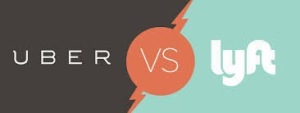As of September 2014, the San Francisco and app-based Uber ridesharing network of private car and peer-to-peer drivers was available in 45 countries and more than 200 cities worldwide. Lyft, which also parks their headquarters in San Francisco, is in 63 U.S. cities. True, Uber had a head start on Lyft, but still! Talk about accelerating brand growth!
There are others entering the race, like Sidecar, also based in San Francisco, (their slogan, “A Whole New Way to Get Around”, although there has been this thing called “carpooling” around since WWII. Just saying.) but currently is in only about a dozen cities or so. You can find other rideshare services locally via an app or (very likely) on an index card on your company break room, but right now Uber and Lyft are the two big app brands.
Uber (“Everyone’s Private Driver”) and Lyft (“Your Friend With A Car” – assuming your friend has a fuzzy, pink mustache on the front bumper of the car coming to pick you up) are currently the two most popular of the on-demand, app-based rideshare car services. Both are known for their very competitive, and sometimes controversial, approaches to acquiring customers and recruiting drivers.
In the face of accusations of extreme price surging (charging higher prices for rides when demand is high, like holidays or bad weather) and aggressive recruitment tactics, Uber’s CEO Travis Kalanick described his company as “scrappy.” PayPal co-founder, Peter Thiel, (and an investor in competitor Lyft) on the other hand was quoted as saying, “If the slogan for Google is ‘Don’t be evil,’ the slogan for Uber should be ‘Do a little evil and don’t get caught!’” Both companies have accused each other of booking the competition and then cancelling rides at the last minute.
When Uber started, they only offered full-sized luxury cars, under the name of “UberBlack,” but in 2012 they launched “uberX,” which made smaller vehicles available for rideshares. That program charges lower fees, and became competitive not only with other rideshare brands, but with traditional, local taxi services as well.
In fact, in a blog posting last week, Uber announced that the 20% price cut for its lower-end UberX fleet they introduced in New York City this summer would become permanent: “From Brooklyn to the Bronx, and everywhere in between, uberX is the most affordable ride in the city.” But while lower fees may be paying off for the company, not everyone agrees. Uber drivers say it comes right out of their pockets, and they’re not happy.
Just as Uber and Lyft are racing to prove themselves the most innovative and passenger-friendly rideshare app in a growing industry, they both received the green light for curbside pickups at Nashville International Airport (NIA), the very first airport to officially recognize rideshare services.
Both services currently pick up riders at airports, but taxi services and airport operators have consistently maintained that this is illegal, with the service banned at Los Angeles, Memphis, Raleigh-Durham, and (ironically enough) San Francisco airports. To operate legally at NIA, the companies will have to apply for permits, pay user fees, and be plainly identified. No comment was made whether a pink mustache would be adequate in that regard.
Not to be a drag on this race, but in New York another provider is going to give both Uber and Lyft a run for their money. A Tel Aviv-based company is introducing a rider-driver connection app named “Gett” (which, paradoxically, translates from Hebrew to “divorce document,” perhaps not the best name for a service that purports to be a rider-driver matchmaker. But as we say in New York, “Go know!”). They just announced an introductory deal that will run though the end of this year for a ride any time, under any traffic conditions, any place in Manhattan for $10. So some real price competition for Uber and Lyft. And NYC’s yellow medallion cabs. And, in light of the Lyft-Uber accusations of sabotage and price surging, perhaps an attempt at a more transparent and straightforward brand model, if not the best name in the world.
Anyway, we are unable to comment upon the veracity of the accusations flying back and forth between the two, current category leaders, but will include flag-to-flag rideshare app coverage in our upcoming January 2015 Customer Loyalty Engagement Index.
As a born-and-bred New Yorker, I can say this: The average speed of crosstown transport has not changed in nearly 100 years, and saving some time getting transport and some money on a trip from the Eastside to the Westside (or vice versa) would be greatly appreciated. As a former NYC taxi driver in my youth, I can knowledgably quote the old driver maxim, “Manhattan is 10 miles long and 3 hours wide!”
As professional branding consultants we can also say that consumers always appreciate – and benefit from – having more options. But especially when brands have to compete to see which can best meet your expectations.
The ones that can are always the brand that crosses the loyalty – and profitability – finish line first.
Find out more about what makes customer loyalty happen and how Brand Keys metrics is able to predict future consumer behavior: brandkeys.com. Visit our YouTube channel to learn more about Brand Keys methodology, applications and case studies.
Share this:
